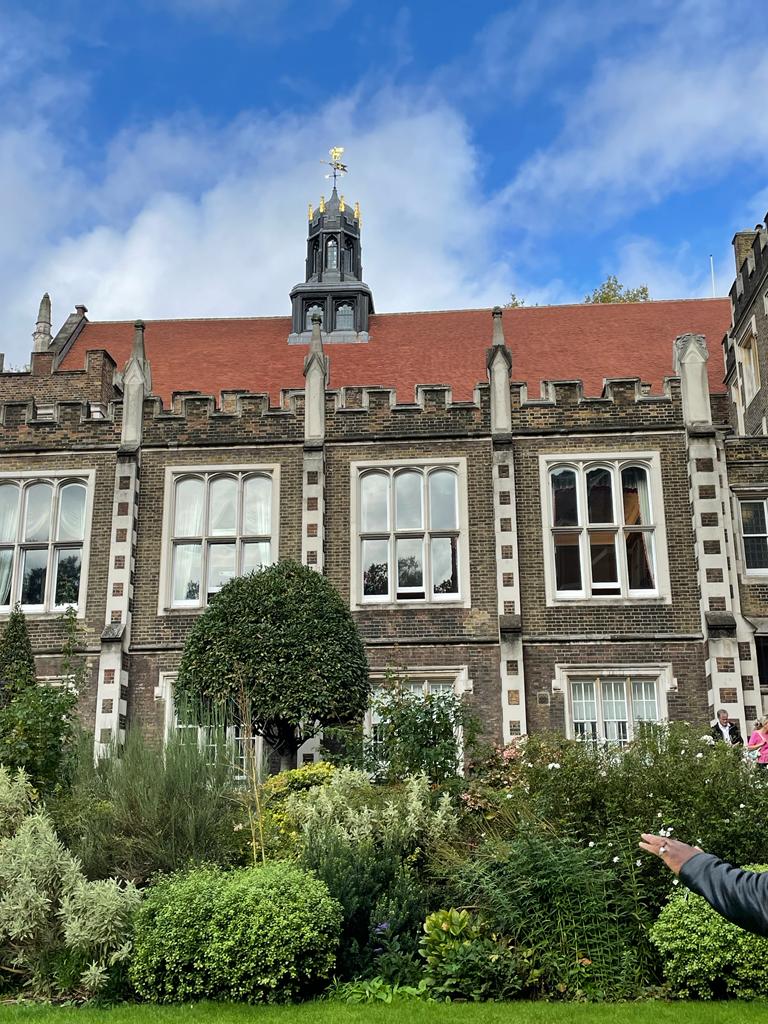
By Robina Dam.
The chance to get a sneak peek in what almost seems to be behind closed doors — the historic Middle Temple, one of the four Inns of Court — drew in what has been the largest gathering of the Art Talks group this year. Our sizeable group took this opportunity to see a place that is barely known even by those who have lived in London all their lives. For all the buses that are bustling down the busy Fleet Street, you could easily miss the narrow, winding road leading off, almost opposite the iconic Royal Courts of Justice.

Within minutes you are in the hidden world of London’s legal heart. When you can hear birds chirruping up in the trees on a weekday morning, you simply would not guess that you were right in the centre of some of the capital’s busiest neighbourhoods, a stone’s throw from the Strand and the Aldwych.

Yet, here around 700 years ago, was when the Knights Templar, who travelled to the Holy Land during the period of the Crusades, chose to base their London interests. The actual Temple Church (www.templechurch.com is also open for sightseeing and historic talks for the public) on Middle Temple Lane was where in the 12th century the Knights Templars’ religious and political activities also saw them needing much legal advice.

This was all brought to life for us in a special guided tour by Richard Frost, Middle Temple’s outreach officer, who explained why the neighbourhood of the Inns of Court (Grey’s Inn, Middle Temple, Inner Temple and Lincoln’s Inn) were solely devoted to legal life.

“In 1608, Middle and Inner Temple reached an agreement with the Crown that these estates could only be law-related for work and living. That’s why there are no modern build high-rises here although I’m sure some people want to!”

Richard then led us under the archway to the jaw-dropping dining hall. Officially opened in 1573, the Middle Temple Hall has certainly stood the test of time, though its battering during World War Two’s Blitz can be seen in some of the historic pictures. [Photo shown.] Unusually for its time, when columns were usually needed to hold up high ceilings, this ahead-of-its-time architectural concept saw a double-hammer beam roof holding up the ceiling with pride of place given to the 29foot long oak table.

Legend has it that the table was gifted by none other than Queen Elizabeth I herself. “That’s why we have her portrait there,” points our guide Richard with a smile. She was one of the many distinguished guests to have eaten here along with Sir Walter Raleigh; and it’s that very same table that is still used today.

One cultural point of interest is that William Shakespeare’s famous play Twelfth Night was believed to have been first performed here.
At the back of the hall, our attention was drawn to the very detailed wooden screen, with its carvings of mythical figures. The quality of the work indicated that it was done by Huguenot refugees, who came to England from France in the 16th-17th centuries. Appreciating the role that immigrants have played in historic England clearly came out in this tour and we were privileged to also visit the Prince’s Room, named after Prince William as the royal connections continue.
Anya and Joanna then took us for coffee and biscuits to practice our historic vocabulary. Armoury and helmets, anyone?
Thank you to Mishcon’s team (Eleanor Dixie, Megan Judd, Tina Kondouli, Alicja Surmiak) and volunteers Robina Dam, Kal Mohammed and Bridget Palmer.
Middle Temple Middle Temple Lane, London EC4Y 9BT; middletemple.org.uk/tours
Tours for members of the public can be organised by contacting the Events Department (020 7427 4820) at least a week in advance at a cost of £12 per person with a minimum of 10 people in a group.
(Photos supplied by Joanna Bevan & Robina Dam)

Social